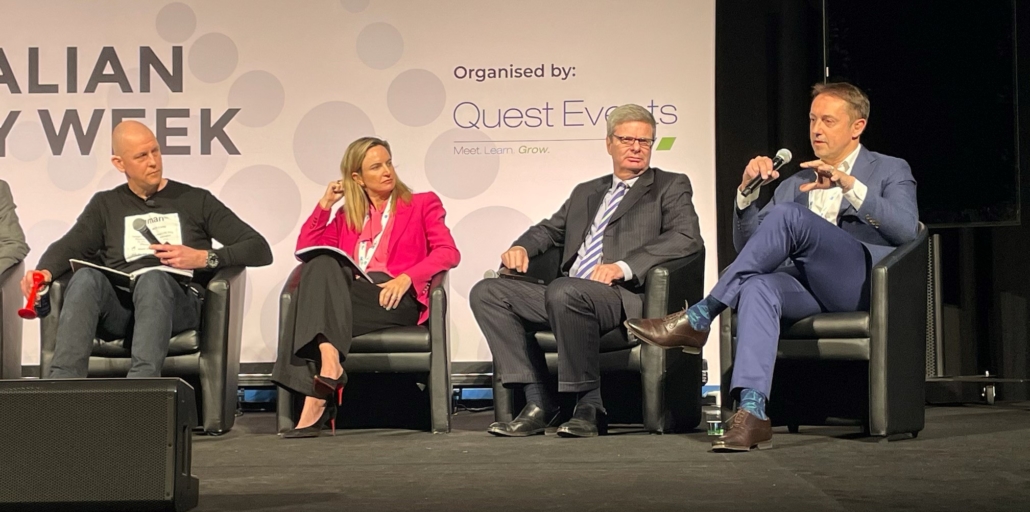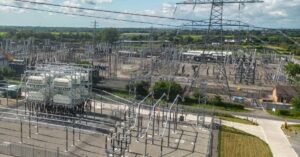

CEO of US-based power technology company provides assessment on emerging trends and blueprint for grid evolution
June 8, 2022
Peter Wells, Chief Executive Officer of global power technology company, Smart Wires, provided an international perspective on the future of energy during a live panel discussion with other industry experts on “game-changing technologies” at the Australian Energy Week Conference yesterday.

Throughout the lively and candid discussion, panel members debated the emerging technologies which are set to be critical in reaching net zero, the need for a digital platform, and the importance of pursuing integrated solutions.
Mr Wells, who hails from England but is based in the United States, stated a mix of Grid-Enhancing Technologies (GETs) were emerging globally as central to enabling a successful energy transition.
“More and more GETs are being deployed across the world – DLR [dynamic line rating], topology optimization, modular power flow control. Why? because its fast, lower cost, and brings flexibility,” he said.
“We’re also see regulators in some markets flat out requiring it. It’s coming. It must be built into planning.
“We find with our customers across the globe that it is somewhat transactional at the moment – we’re solving a specific problem like grid congestion. We’re maybe five years away, but [in the future] you’ll have a distributed base of technology that now you can do different things with,” Peter said.
“Just listening to all the conversations today, including on this panel, the complexity of what we’re trying to deal with, how you even get there without power electronics – it’s going to be impossible.
“We need some form of digital platform that’s edge to edge, that can deal with electrification, that can deal with flexibility.
“As the saying in Australia goes, ’there’s no transition without transmission’, so maybe it’s no transition without digital transmission and distribution,” Peter said.
Peter praised the Australian energy industry on its “pragmatic and transparent approach” to energy policy and incentivized regulation.
In response to a question on whether the mentality (in Australia) is changing far enough and quickly enough in terms of the need to get a better picture of what is actually needed on the grid before building a long-term infrastructure asset, Peter said:
“Power electronics and other GETs are complementary to what is already there today. You do need all of it at the end of the day. It’s really important that when you invest in the grid, distribution of transmission, you’re thinking about that future flexibility.”
He mentioned Australia, the UK and Colombia as his picks for top global markets in terms of incentivized regulation.
“I can tell you now, Smart Wires’ most successful markets are in countries that have regulatory mechanisms to ensure the delivery of a reliable, low-cost network for consumers – approaches that naturally incentivize utilities to rapidly adopt GETs (grid-enhancing technologies). Australia is firmly in that mix, developing a market which is driving the energy transition on a cost basis,” he said.
“Notwithstanding the progress made, the pace of change is presenting significant challenges here in Australia just as it is elsewhere in the world. There needs to be far greater focus on the grid itself and transforming it into a digital platform,” Peter said.
“Ultimately, to successfully achieve a global energy transition will require genuine integration – interconnectedness of markets, policy and technology,” he said.
Smart Wires’ technology, SmartValve™, is now being deployed in Australia, with a major installation on the Victoria-NSW Interconnector (VNI) with Transgrid, an installation with AusNet Services in Victoria; and an installation with another Australian utility almost completed – combined these deployments will unlock an extra 200+ MW on Australia’s network.
Active across the UK, Europe, North and Latin America, and Australia, SmartValve is in use or being installed on live projects with 20+ grid operators worldwide: our largest installation being with National Grid UK, where our technology has unlocked 1.5 GW on the existing network.
For press related purposes, please contact us at marketing@smartwires.com.
Dive deeper into related content
Explore our products and services
Talk to our experts

